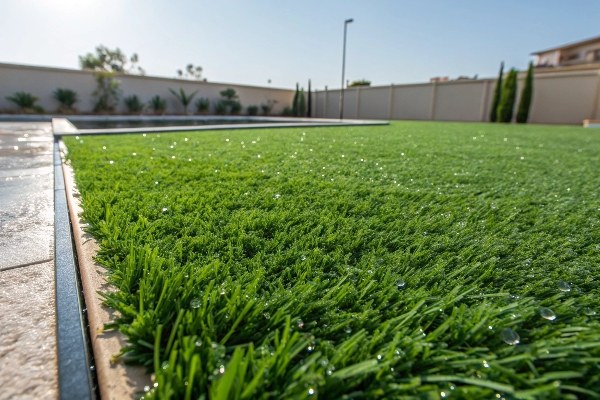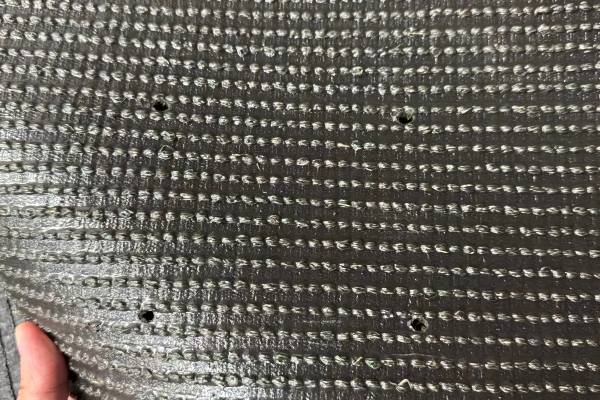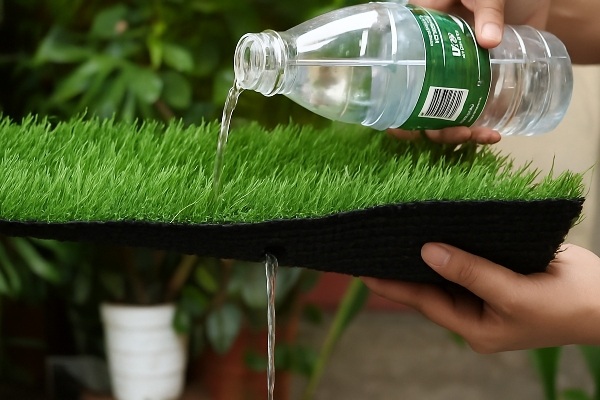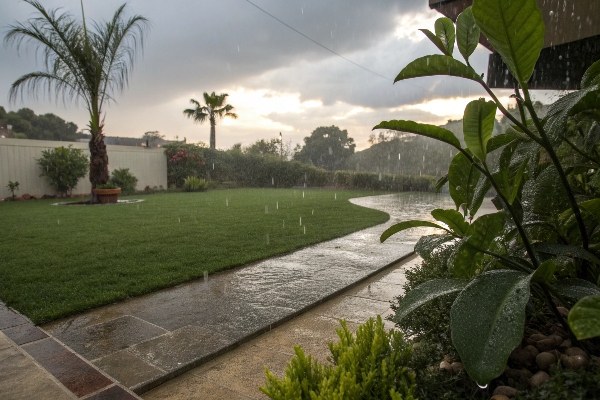Are you tired of rainwater turning your lawn into a muddy, unusable swamp? This can ruin your outdoor plans. A permeable artificial turf system is the perfect solution.
Yes, artificial turf is specifically designed to be permeable to water. It features drainage holes in its backing and is installed over a permeable sub-base. This entire system works together to allow water to drain through efficiently, preventing puddles and keeping the surface dry and ready for use.

This excellent drainage capability is one of the biggest advantages of artificial turf over natural grass. Many people are surprised to learn just how well the system works. But you probably want to understand the details of how it handles water. Let’s get into the specifics so you can see why it’s such a reliable choice for homes, sports fields, and commercial projects. Understanding this will give you confidence in your investment.
Does water pass through artificial turf?
Worried that your new artificial lawn will hold water like a bathtub? A waterlogged surface can cause delays and damage. Learn exactly how our turf allows water to pass through.
Absolutely. Water passes directly through the artificial turf itself. The turf has a backing material with consistently spaced drainage holes. These holes let rainwater and other liquids flow away from the surface and into the prepared sub-base below.

To really understand how this works, we need to look at the construction of the turf. In my early days working in a turf workshop, I learned that the backing is just as important as the grass fibers themselves. It’s the foundation of the whole product. A good drainage system starts here.
The Turf Backing System
Every piece of artificial turf has a backing that holds the grass fibers in place. This is where the drainage starts. The backing has two main parts. First is the primary backing, which is the fabric the fibers are tufted into. Second is the secondary backing, a coating applied over it to lock everything together. After this coating is applied and cured, precision machines punch drainage holes through both layers.
The number and size of these holes determine the basic drainage rate of the turf itself.
| Feature | Standard Landscaping Turf | High-Performance/Pet Turf |
|---|---|---|
| Holes per sq. meter | Around 80-100 | 200 or more |
| Backing Coating | SBR Latex | Polyurethane (PU) |
| Best Use | Gardens, general use | Pet areas, rainy climates, sports |
A polyurethane (PU) backing is often more flexible and stable, allowing for cleaner and more consistent drainage holes. Getting this manufacturing step right is critical. Even a small error in the process can significantly reduce the turf’s ability to drain water.
How permeable is artificial grass?
You know that water can drain through the turf, but is it fast enough for heavy rain? Slow drainage can still lead to puddles. Let’s look at the impressive permeability of a full grass system.
The permeability of a complete artificial grass system is excellent, often far better than natural grass on clay soil. A properly installed system can typically drain more than 50 liters of water per minute for every square meter. This high rate ensures your surface remains usable even during a downpour.

The key word here is "system." The turf itself is only one part of the equation. The real hero of a highly permeable installation is the sub-base prepared underneath it. I have worked on many project bids where the sub-base specification was more detailed and strict than the specification for the turf itself. If you get the foundation wrong, the performance of the entire field fails.
It’s a Complete Drainage System
The overall permeability depends on three components working together:
- Artificial Turf: The drainage holes in the turf are the entry point.
- Infill: Sand or rubber infill sits between the grass fibers. It helps hold them up, but the gaps between the granules allow water to pass through freely.
- Sub-base: This is the most important layer for drainage capacity. It’s a multi-layer foundation built to absorb and channel water away.
Building a Permeable Foundation
A strong, permeable sub-base is built in layers. First, the existing ground is compacted. Then, a geotextile membrane1 is laid down to stop weeds from growing up, but it still allows water to pass down. On top of that, a thick layer of crushed rock or aggregate is added. This layer creates large voids where water can collect and slowly drain into the ground below. Finally, a thin layer of fine granite or sand is compacted on top to create a perfectly smooth and stable surface for the turf. The depth and type of the crushed rock layer define the system’s total drainage capacity.
Can artificial grass be flooded?
You’ve invested in a beautiful turf pitch or lawn, but a flood could ruin everything. Are you worried that extreme weather might overwhelm your artificial grass? Let’s address this important concern.
A professionally installed artificial grass system is highly resistant to flooding. However, in extreme conditions, temporary flooding can happen if the ground is completely saturated or the rainfall is too intense for the sub-base to handle. The good news is the grass itself will not be damaged by the water.

While a good system can handle a lot, it’s not magic. There are situations where you might see temporary standing water. The most important thing is that, unlike natural grass, the artificial turf will recover perfectly.
When Flooding Might Occur
If you experience flooding, it’s usually for one of these reasons:
- Improper Sub-base: This is the most common cause. If a contractor cuts corners and installs the turf over soil or uses the wrong aggregate, water has nowhere to go.
- High Water Table: In low-lying or marshy areas, the ground is already full of water. The sub-base can’t drain effectively in this case and may need special drainage pipes installed.
- Clogged System: Over time, fine dust, leaves, and other organic material can clog the turf’s drainage holes or the top of the sub-base. Regular brushing and occasional rinsing help prevent this.
- Exceptional Weather: A storm that brings a massive amount of rain in a short time can overwhelm any drainage system, natural or man-made.
What Happens After the Water Recedes?
This is where artificial turf truly shines. I remember a client in a coastal area who called me in a panic after a huge storm flooded his entire property. A day later, he called back, amazed. The water on the turf was gone, and his lawn looked as good as new. The mud in the rest of his garden was a disaster. Because the turf fibers and backing are made from plastic and latex or PU, they are not damaged by water. The surface quickly becomes safe and usable again.
Conclusion
A properly installed artificial turf system provides superior water permeability. It handles rain effectively, prevents puddles, and ensures you have a durable, fast-draining surface ready for use in any weather.
-
Understand the function of geotextile membranes in preventing weed growth while allowing water drainage. ↩
_画板-1.png)
_画板-1.png)